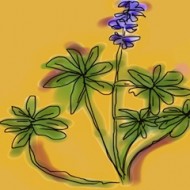The Dry Garden: Fremont’s flower
Some years ago, the website of Native Sons Nursery had a photograph of a California flannel bush that had been trained to grow along a garden wall. Each bloom in a spangle of flowers was the size of a tea cup. Their yellow could outshine a daffodil, or sunflower. This wasn’t a garden, it was a garden that Matisse dreamed. On seeing that photo, so began years of looking in Los Angeles area gardens for espaliered examples of the glorious genus of natives whose botanical name is Fremontodendron.
And never finding one.
It turns out that the photograph was taken in Guernsey by Native Sons co-founder David Fross, who had just left a place that serves alcohol when he saw the glorious display by one of the signature plants of California chaparral growing in one of the Channel Islands between Britain and France. “I’d had two martinis and half …
The Dry Garden: Best dressed list
If the view from your front window is a hedge so maimed by years of buzzing that the only option is to buzz it some more, and if you have better things to do with your money than pay yard crews to torture shrubbery, it may be time to dig out that green wall and start over.
But before sharpening the pickax, dream. Dream aloud. There is no better time than February to view California’s native lilac, lemonade berry, coffeeberry, gooseberry and barberry plants, most of which are in full flower at Rancho Santa Ana Botanic Garden.
A tour of Southern California’s best native garden in midwinter reveals these shrubs dripping with gold, white, pink and blue flowers. Although the blossoms are admittedly fleeting accessories, they are succeeded by berries.
Apologies for language that sounds like red carpet commentary. It’s unfair to the plants. Click here to keep reading …
The Dry Garden: Lili Singer
On March 5, what has amounted to a year-long birthday party will conclude with a gala at Descanso Gardens. Everyone with $75 and a love of native plants is welcome to attend a shindig marking the 50th year of the Theodore Payne Foundation for Wildflowers & Native Plants.
Celebrating the stoic glory of our native flora is a great cause, but this isn’t just about the birthday of an organization affectionately called Teddy Payne by KPCC radio host John Rabe. It’s not even about the English seedsman for whom the foundation is named. It’s about the foundation’s special projects coordinator, the homegrown horticulturist Lili Singer, who turns 61 on Saturday and whose nearly four decades of garden teaching in Southern California has much to do with the rise of not only the Theodore Payne Foundation, but also the Los Angeles County Arboretum & Botanic Garden, the Southern California …
The Dry Garden: Better than beautiful
The former librarian at the Los Angeles County Arboretum & Botanic Garden doesn’t remember exactly when the visitor wandered into her office and let drop that he was a descendant of George Engelmann. What Joan De Fato does remember is telling him that there was a grove of rare oaks on the site that had been named for his ancestor.
You don’t have to be a descendant of one of the fathers of American botany to share in what De Fato recalls as his pleasure and amazement. The arboretum’s grove of Quercus engelmannii, pictured above, is one of the last local stands of a native tree once so common to the foothills that an alternate common name is the Pasadena oak.
The first thing that strikes you upon reaching this group of roughly 200 trees is how much more animated it is by birds, butterflies and scampering lizards …
The Dry Garden: “Capacity” = good nurseries
The potential for gardeners here to conserve water while glorying in the California experience is as big as the state. Yet most of us don’t seize it. According to local water managers, the problem is “capacity.”
By capacity, they refer to the ability of chain home improvement stores to stock drought-tolerant native and Mediterranean-climate plants alongside water-hungry turf. Building native-plant capacity in big-box stores is tough. The inventory get watered to death by untrained staff, who don’t know what the plants are much less what they need. So “capacity” tends to be code for “forget about it” when the subject of water conservation comes up.
Well, water managers, reality check. Nursery capacity for native plants is increasing, albeit slowly. A network of independent specialist nurseries is emerging. Most of these not only have trained staff to sell native plants but also offer courses on how to design gardens and how …
« go back — keep looking »

